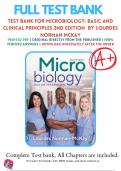Exam (elaborations)
Test Bank Microbiology Basic and Clinical Principles 2nd Edition By Lourdes P. Norman-McKay 9780136785750 | All Chapters with Answers and Rationals
- Course
- Institution
- Book
Test Bank Microbiology Basic and Clinical Principles 2nd Edition By Lourdes P. Norman-McKay 9780136785750 | All Chapters with Answers and Rationals ISBN: 9780136785750 Number of Pages: 381 Number of Chapters: 21 Enhance your understanding of microbiology with the Test Bank for Microbiology: ...
[Show more]



